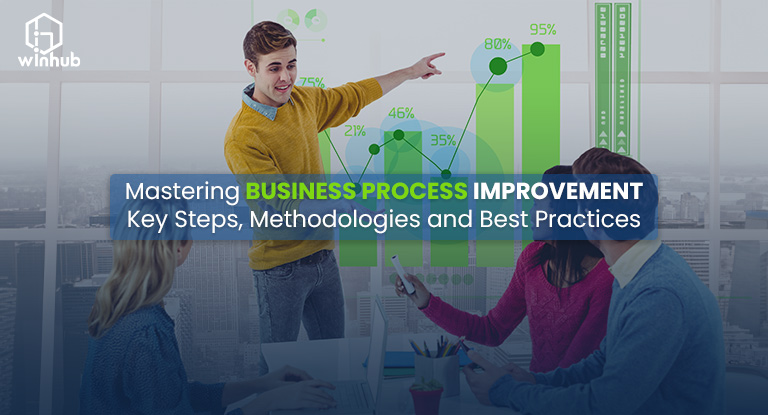Every business owner knows there is a myriad of processes and procedures to manage. A lot of them are repetitive, so they must be streamlined and efficient because any disruption or bottleneck can mean a significant loss for the owner. In addition, every department and team member has its own set of procedures, which might not be operating as efficiently as possible, which can hurt the growth and success of a business. Enter business process improvement — a methodical way of identifying, analyzing, and improving processes.
What is Business Process Improvement?
Business process improvement (BPI) refers to the systematic approach of identifying, analyzing, and enhancing business processes — both formal and informal — within an organization to optimize efficiency, productivity, and overall performance. It involves evaluating how tasks are currently being performed, identifying areas for improvement, and implementing changes to make those processes more effective, streamlined, and aligned with organizational goals. By conducting BPI, businesses can reduce unnecessary expenses, boost productivity, and even improve customer satisfaction.
Why Should a Business Implement BPI?
Though BPI might seem like just another bit of red tape getting in the way of actual work, going through the process and sticking with the outcomes can have significant benefits for a business as well as individual employees. In addition to cutting out unnecessary expenses, BPI can also identify operational constraints and help leadership redirect resources to make work easier. It also provides an opportunity to consider investing in task automation software, incorporating novel technology, or redesigning communication and collaboration flows — areas that might be denied if brought to leadership outside of a BPI process.
BPI can also improve quality, leading to higher customer satisfaction that drives growth. By maximizing operational efficiency, businesses can shorten production cycles and reduce errors. Employee retention is another benefit of BPI; by providing an opportunity for employees to offer suggestions and implementing changes that make their jobs easier, employees are more likely to stay with the company and embrace the culture of improved efficiency and quality.
Steps to Complete BPI
Though there can be different frameworks, BPI generally follows the same six stages:
- Identify the business’ processes.
-
- Define the scope: Determine the boundaries and objectives of the BPI initiative. Identify which processes are critical, where improvements are needed, and how they align with organizational goals.
- Map the processes: Document the current processes using techniques like flowcharts, swim lane diagrams or process maps. This helps visualize the sequence of activities, roles, inputs, outputs and decision points within the process.
- Analyze the processes.
-
- Identify bottlenecks and Inefficiencies: Analyze the mapped processes to pinpoint areas that hinder efficiency, such as bottlenecks, redundancies, delays or errors.
- Collect data: Use data and metrics to quantify the performance of current processes, incorporating things like cycle times, error rates, resource utilization or customer feedback. If these things aren’t currently collected, incorporate them into the process.
- Set objectives.
-
- Establish goals: Define clear and measurable goals for the BPI initiative. These could include objectives related to cost reduction, improved quality, faster delivery times, or enhanced customer satisfaction.
- Prioritize improvements: Determine which process improvements will have the most significant impact on achieving the established objectives.
- Redesign the processes.
-
- Generate ideas: Brainstorm and gather input from stakeholders, employees and experts to come up with suggestions to improve the identified processes.
- Develop solutions: Select the most viable improvement ideas and develop new process designs or modifications. This might involve reorganizing tasks, changing workflows, introducing new technology, or refining existing procedures.
- Test and implement.
-
- Conduct a pilot test: Implement the redesigned processes on a small scale or in a controlled environment to assess their effectiveness and make room for adjustments before a full-scale rollout.
- Train and communicate: Train employees on the new processes and communicate the changes across the organization to ensure everyone is aligned and aware of their roles.
- Monitor and continuously improve.
-
- Measure performance: Continuously monitor the performance of the implemented changes using metrics established in step 3.
- Improve and adapt: Gather feedback from stakeholders and employees to identify areas that still need improvement or adjustments.
In addition to these six steps, there are two more vital stages that businesses may overlook when working through BPI. Once improvements have been implemented, it’s vital to document the new processes across the board and ensure all company materials support the new improvements. And perhaps most importantly, once a BPI initiative is complete, celebrate the achievements and recognize the employees! BPI may not always be welcomed at first, but by taking the time to highlight employee contributions and emphasize their vital role in the process going forward, employees will be more likely to embrace BPI.
Bring In a BPI Expert
Though you’re an expert in your business, WinHub is an expert in BPI. Our staff have helped numerous companies through this process, utilizing various methodologies and tools such as Six Sigma, Lean, Kaizen and Business Process Reengineering, among others, depending on the specific needs and goals of the organization. Our ultimate aim is to create more efficient, effective, and agile operations that contribute positively to the overall success of the business. Reach out to us today by visiting WinHub’s Process Mapping and Improvement page to discover how our expertise can help your business.



